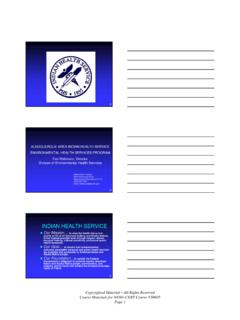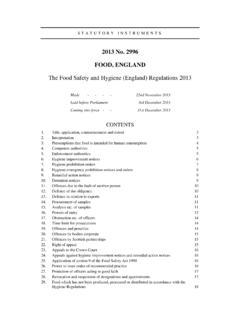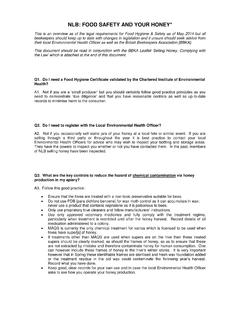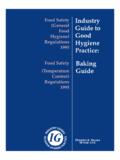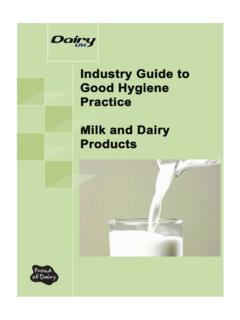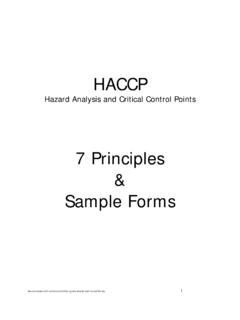Transcription of Certified Professional of Food Safety Credential ...
1 Certified Professional of food Safety Credential Examination Review Guide Second Edition Martha Smith Patnoad, MS, CP-FS Author: Martha Smith Patnoad, MS, CP-FS Editor: Heidi J. Shaw 2006 National Environmental Health Association Published by National Environmental Health Association All rights reserved. No part of this book may be reproduced, in any form or by any means, without permission in writing from the publisher. Printed in the United States of America About the Author Martha Smith Patnoad, MS, CP-FS has been affiliated with the University of Rhode Island Cooperative Extension for over thirty years. She holds a Bachelor of Science and a Masters degree from the University of Rhode Island and a Six Year Professional Certificate in Adult and Vocational Education from the University of Connecticut. For the past 16 years, she has been a Cooperative Extension Professor and food Safety Education Specialist in the Department of food Sciences and Nutrition.
2 In that capacity, she has developed and implemented food Safety education programs for school- age children and their caregivers, educators, volunteer foodservice workers, producers of fruits and vegetables and home gardeners through funded grant projects. Her responsibilities also include coordination of food Safety Manager Certification and Recertification courses offered through the University. She is a member of the National Environmental Health Association and holds a Certified Professional of food Safety Credential . She is a past academic advisor to the Conference for food Protection, Council II and past president of the Rhode Island Association of Family and Consumer Sciences. Martha was NEHA s England Sabbatical Exchange Award Winner in 2000. Her sabbatical experience focused on food Safety education programs in England.
3 In 2003, she was the recipient the University s Outstanding Outreach Award. Ms. Patnoad resides in Richmond, Rhode Island with her husband Edward. Her daughter Aimee is employed as an environmental scientist. Page i Table of Contents Page Introduction 1 How to Use this Study Guide 2 CP-FS Exam Content Outline 3 Chapter Listings (All chapters available for review online) 6 Appendix A: Recommended Reading 7 Appendix B: Glossary 8 Page 1 Introduction This study guide is designed to assist you in preparing to take the National Environmental Health Association s (NEHA s) Certified Professional of food Safety (CP-FS) Exam. To be eligible to sit for the CP-FS exam, candidates must meet the criteria for either A or B, as follows: A.
4 Degree Track: 1. Bachelor's degree in food science or environmental health from an accredited degree program in environmental health; or 2. Bachelor's degree with at least two (2) years of experience in food protection; or 3. Bachelor's degree and possession of the NEHA REHS/RS Credential or equivalent Credential . B. Experience Track: 1. High school diploma or GED and a) five (5) years of progressive experience in food -related work and b) successful passage of the Certified Professional food Manager (CPFM) exam, the food Safety Managers Certification Examination (FSMCE), or the ServSafe exam; or membership in a food -related Professional organization and accumulation of 24 hours of continuing-education experience (presenting a paper or having a paper published can be substituted for four [4] hours of continuing-education experience, up to maximum of two papers); or 2.
5 Associate s degree and a) four (4) years of progressive experience in food -related work and b) successful passage of the Certified Professional food Manager (CPFM), the food Safety Managers Certification Examination (FSMCE), or the ServSafe exam; or membership in a food -related Professional organization and accumulation of 16 hours of continuing-education experience (presenting a paper or having a paper published can be substituted for four (4) hours of continuing-education experience, up to a maximum of two papers). Page 2 How to Use this Study Guide The study guide reviews the content areas included in the CP-FS examination. Candidates also are expected to utilize knowledge of the field acquired through education and experience to prepare for and pass the CP-FS examination. This study guide covers the following topics: Study Skills and Test-Taking Strategies, Microbiology of Foodborne Illness, Cause and Prevention of Foodborne Illness, Hazard Analysis Critical Control Point (HACCP) Principles, Investigating a Foodborne-Illness Incident/Outbreak, Public Health Law as the Basis for Inspections, and food Establishment Inspection Process.
6 Each chapter includes: 9 a brief introduction to the subject, 9 key concepts, 9 key words and definitions, 9 review of the subject matter, 9 applicable sections of the U. S. FDA s 2005 food Code, 9 sources of additional information on the subject matter, 9 five CP-FS exam practice questions from the topic area, and 9 study questions. Before you begin your studies for the CP-FS examination, please review Chapter I of the study guide, Study Skills and Test-Taking Strategies. The information presented in this chapter will guide your examination review. Please review the CP-FS Exam Content Outline on pages iii - v. The test is designed to assess the competency of practitioners in the field. The exam content outline highlights the knowledge areas that the test encompasses. The appendix includes answers to the study questions from each chapter, a glossary, and a listing of study references, including texts and Web sites, which you may find useful in your preparation for the CP-FS examination and in your work a food Safety Professional .
7 Study Guide This study guide was designed with the purpose of aiding candidates in preparing for the Certified Professional of food Safety (CP-FS) credentialing examination. However, the guide is not designed to provide answers to all of the questions that appear on the examination. Rather, it is designed to help the candidates to better understand their individual strengths and weaknesses. The study guide allows for this self-assessment and identifies the additional resources for review. The study guide provides an overview of the examination and enables the candidate to determine the areas where more preparation is needed. Page 3 CP-FS EXAM CONTENT OUTLINE I. Causes and Prevention of Foodborne Illness 28% of exam 1. Differentiate between foodborne illness and foodborne outbreak 2. Differentiate between the cause of foodborne infection and foodborne intoxication 3.
8 Recognize the major types of microorganisms/toxins that cause biological contamination 4. Identify the common types of bacteria and virus and associated illnesses and symptoms 5. Identify the common types of parasites and fungi and associated illnesses and symptoms 6. Define foods that are potentially hazardous 7. Identify biological, physical and chemical contamination 8. Demonstrate knowledge of the hazards associated with cross contamination 9. Demonstrate knowledge of the personal hygiene and employee health to food Safety 10. Demonstrate knowledge of the relationship between hand contact and foodborne illness (hand washing) 11. Demonstrate knowledge of the relationship between poor personal habits and foodborne illness 12. Demonstrate knowledge of the relationship between employee illness and foodborne illness 13. Demonstrate knowledge of the hazards of contamination and pests as they relate to foodborne illness 14.
9 Assess the potential for foodborne illness in a food establishment 15. Evaluate standards, policies and procedures for preventing foodborne illness 16. Describe the HACCP Program 17. Prevent hazards prior to and during receipt of food 18. Prevent hazards during food storage 19. Prevent hazards during food preparation 20. Prevent hazards during food service and display 21. Prevent hazards during re-service of packaged foods and service of stored, previously prepared foods 22. Prevent hazards during transportation of food 23. Improve practices and procedures, self inspection procedures 24. Practice and promote personal hygiene 25. Prevent people with food transmitted diseases from working in the food service establishment 26. Demonstrate knowledge of cleaning and sanitizing utensils and equipment, correct use of chemicals for cleaning and sanitizing, and practices for manual and mechanical warewashing 27.
10 Demonstrate knowledge of allergens and their symptoms, and labeling of food products for allergens II. Knowledge of food Safety Inspections 21% of exam 1. Knowledge of how to observe the facility and personnel practices carefully 2. Knowledge of inspector s proper attire 3. Demonstrate knowledge of collecting data in a scientific manner 4. Analyze inspection findings 5. Determine corrective action required 6. Document inspection 7. Demonstrate knowledge of equipment operation principles 8. Calibrate test equipment 9. Perform accurate measurements and calculations 10. Demonstrate an understanding of how to interpret test results 11. Identify unique variables of institutional high risk populations 12. Examine receipt and storage of food and supplies 13. Assess food preparation facilities and procedures 14. Assess water supply, vector control, and waste management methods 15.

